SEO Strategy: 10 practical steps for website SEO optimization in detail
If you want to rank higher in Google rankings, then this guide is for you.
Steps of the latest website SEO optimization process in 2024:
What is SEO strategy?
An SEO strategy is a plan to create, optimize and promote content to increase its visibility in search engine results, thereby attracting more natural traffic to a website. It involves a variety of techniques such asKeyword research, page optimization,Technical SEOand link building.
In other words: an SEO strategy is the process you follow when you want more natural traffic.
Step 1: Create a list of keywords
Keyword research is usually the first step in any legitimate SEO strategy.
What is one of the best ways to find the keywords your target customers are searching for?
Google Suggest (drop down words)
Type a keyword into Google's search field and it will bring up a list of suggestions:
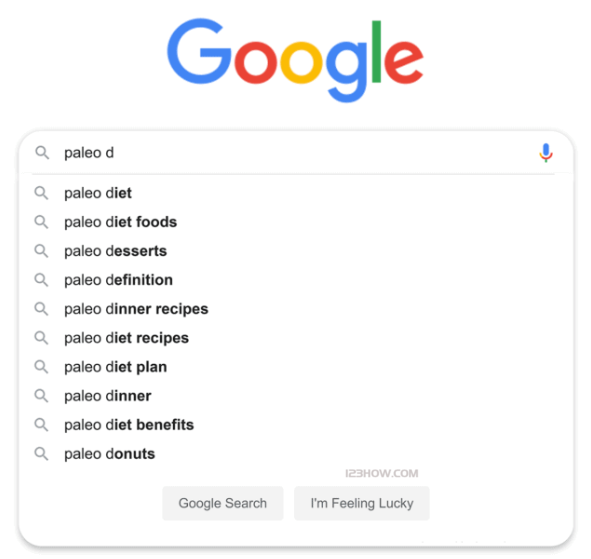
In addition, longer keywords (called "long-tail keywords") tend to be less competitive than "short-tail" terms.
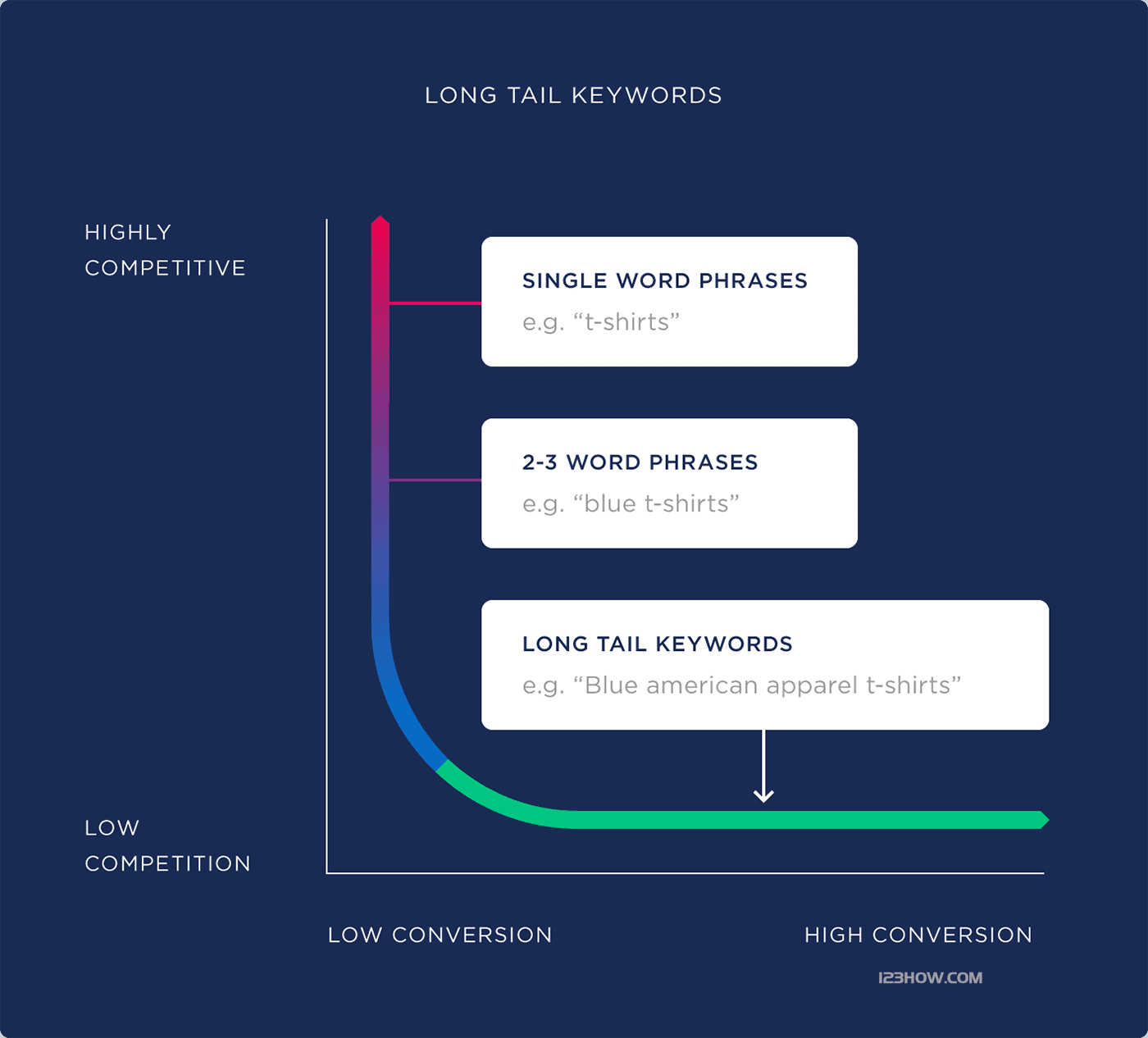
As a result, long-tail terms are more likely to rank even though they have a relatively low search volume.
I recommend typing in a few different keywords into Google until you have a list of about 10 keywords.
in the event thatyouTo see the search volume and competition level for these terms, you can use the Semrush maybe Ubersuggest and other keyword tools.
Once you've memorized 10 keywords, you're ready to move on to step 2.
Step 2: Analyze the first page of Google
Okay, so you found a few keywords.
Now it's time to see who has gained rankings for these keywords, just type in one of the keywords found in Google and make a note of theyouAny site type noted.
For example, the search results page for "SEO tools" is full of tool lists:
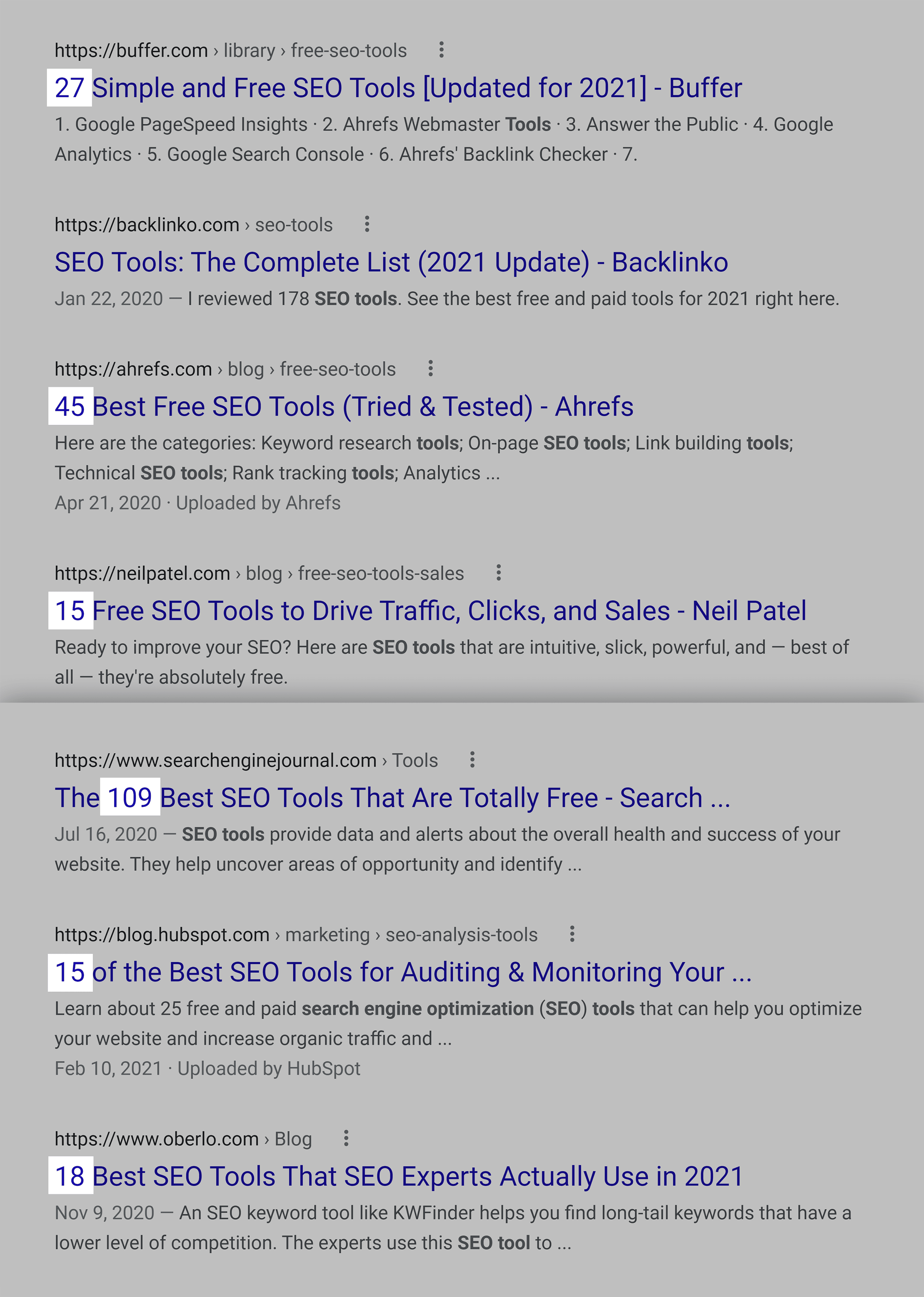
So if you want to cover that topic on your site, you need to be aware that the first page of results is primarily list posts.
And you might want to publish a list post on your blog.
Step 3: Determineyourivalry
My favorite SEO competitor analysis tools are Semrush. Their tools make the process very easy and can save you a lot of time.
First, click on "Domain Overview" and type inyouThe URL of the
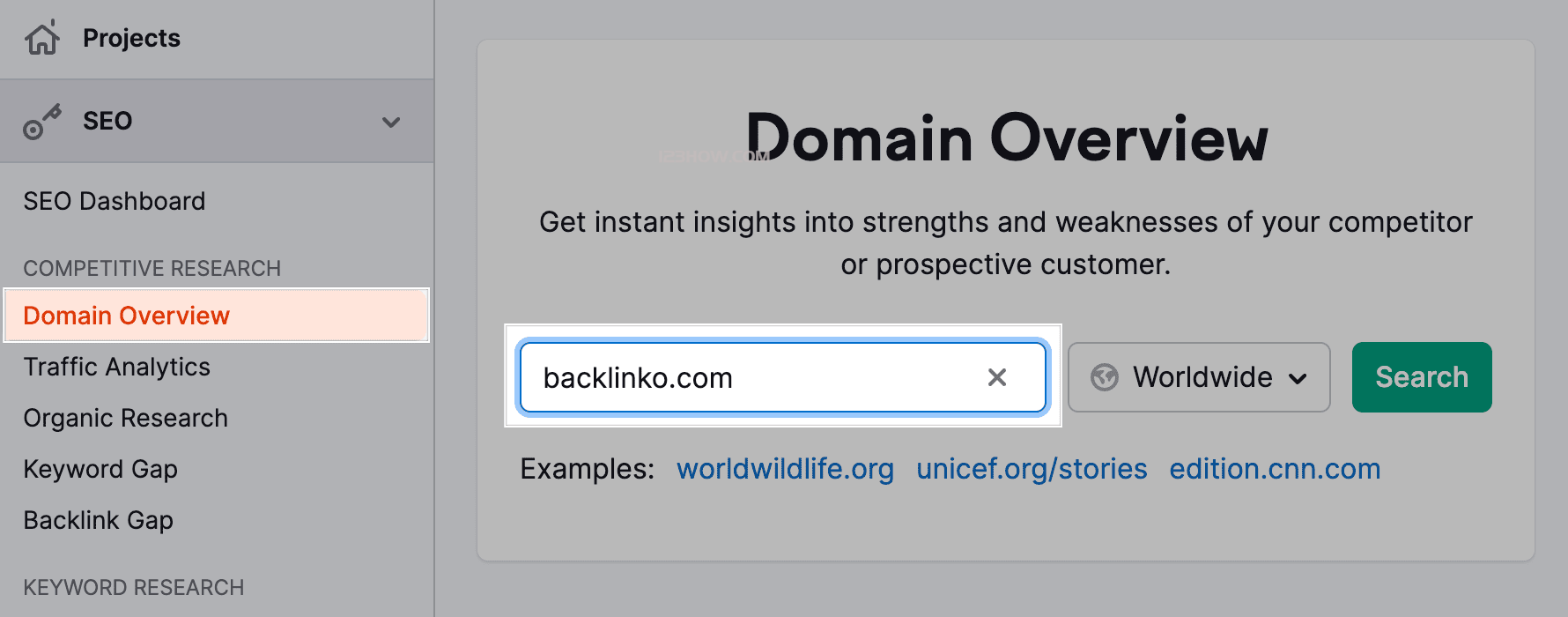
Then scroll down to the bottom and you'll find a section called "Major Organic Competitors".
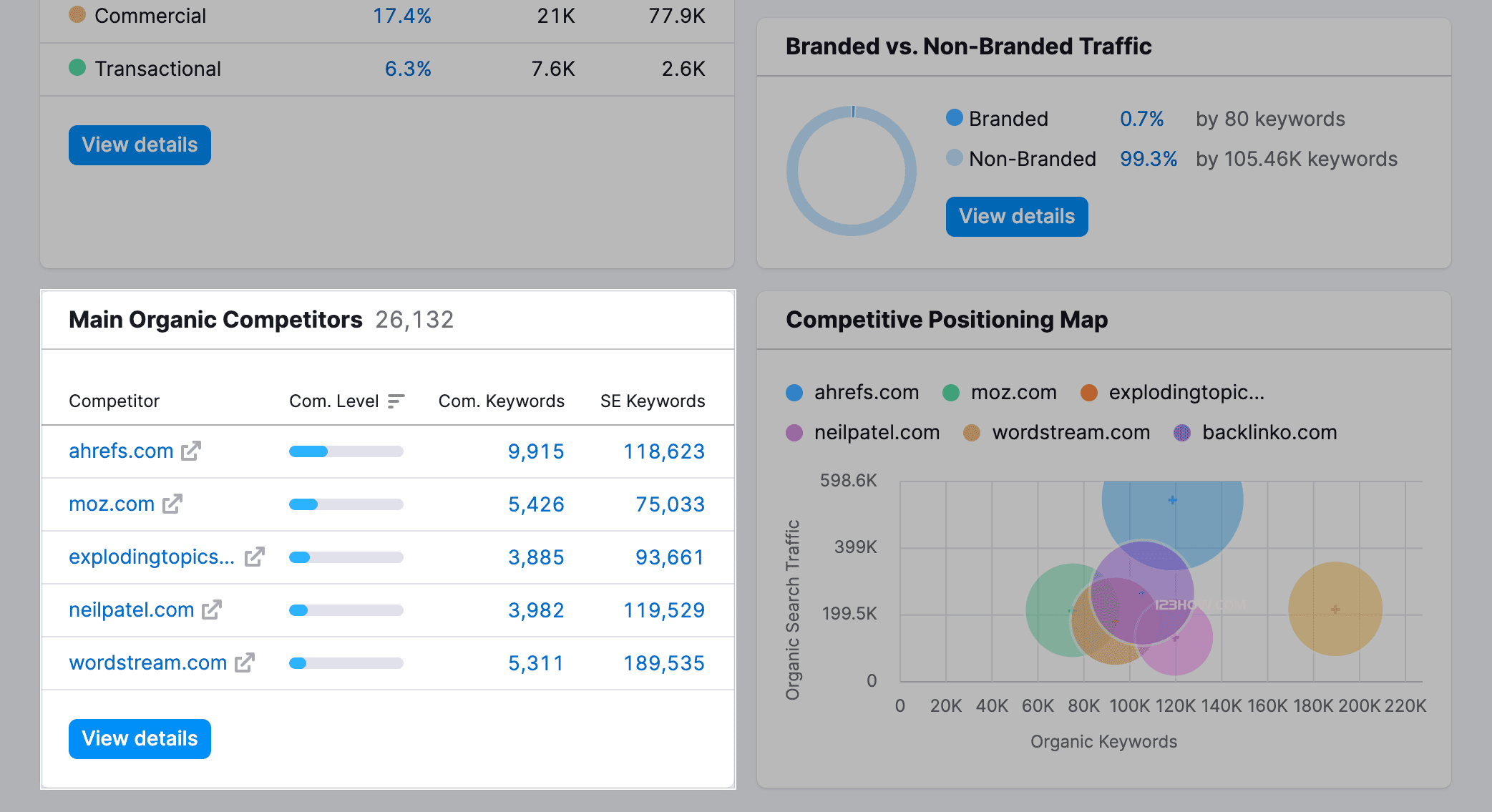
These competitors are targeting similar keywords and targeting keywords related toyouSimilar audiences to rank sites.
in the event thatyouClick "View All..."Button.youWill be able to view all competitors as well as more in-depth information.
youViewableyouand how many common keywords these domains share and how much traffic these sites attract:
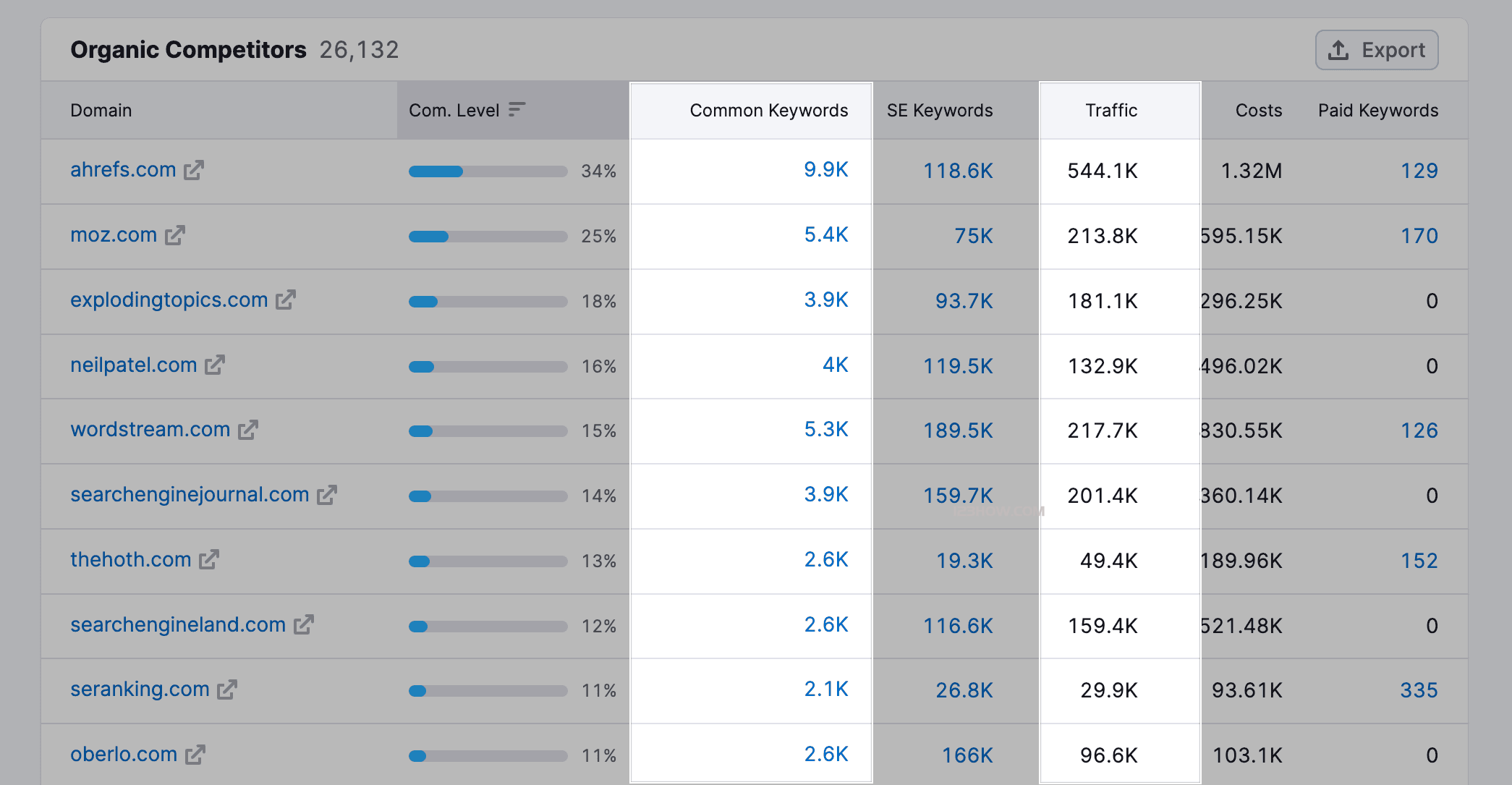
The "Common Keywords" section is very useful, as it allows you to provide a list of the most common keywords to theyoudemonstrateyouTotal number of keywords shared with each site.
If you see sites with tons of common keywords, then you can assume that they are your competitors.
At the end of this step, theyouAt least 4-5 major organic competitors should have been identified.
Step 4: Create something different or better
It's time to create some super high quality content. When it comes to SEO content, theyouThere are two options:
Option 1:Create something different.
Option 2:Create something better.
Sometimes you want to create something bigger and better than an existing product (aka skyscraper technology).
But sometimes you're better off using completely different content.
Why?
Because it makes your content stand out.
For example, a while back, I sat down to write a piece of content around "mobile SEO" optimization. And I noticed that the first page of Google was flooded with list posts like "X kinds of mobile optimizationyouA Website Approach."
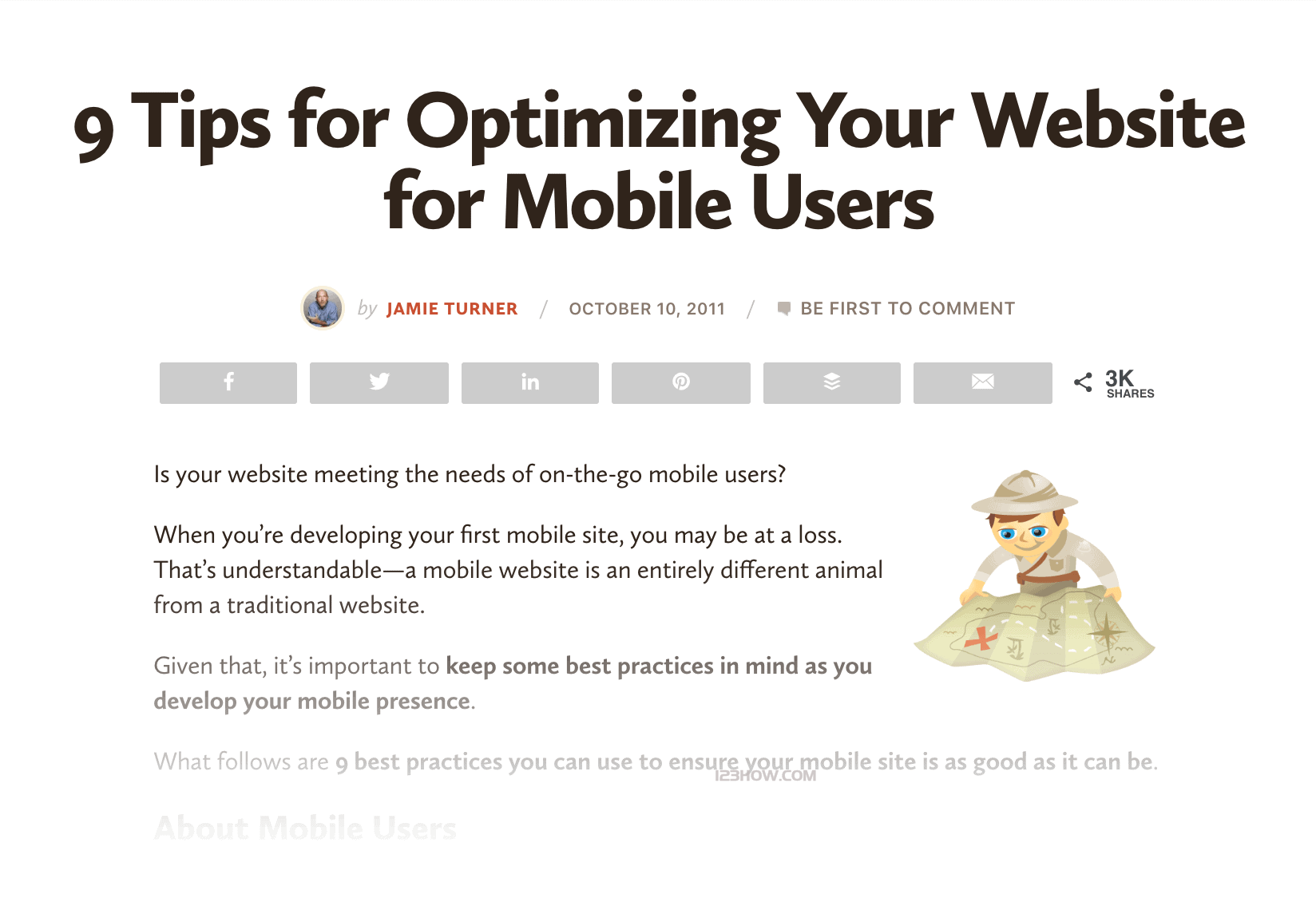
Current: I could have created a larger list post, e.g., "150 mobile optimizedyouA Website Approach."
But that didn't make any sense. Instead, I created something completely different.
Specifically, I published an ultimate guide on mobile optimization. And because my content stood out, it got tons of shares. And most importantly, backlinks.
So, how do you publish something better than the content that's already ranking on the first page of Google?
In this case, you need to publish content that's 10x better than what's already out there.
For example, not too long ago, I noticed that most of the content on "SEO Tools" only listed 10-20 tools. And I knew that posting another list of 20 tools wouldn't help.
So I decided to create a list of 41 SEO tools (this post now ranks in the top 3 for the keyword "SEO tools").
Step 5: Add a Hook
If you want to improve your search engine rankings in 2024, you need to get backlinks.
In fact, according to a study published by Stone Temple Consulting on the Moz blog, links are still strongly correlated with Google's first page rankings.
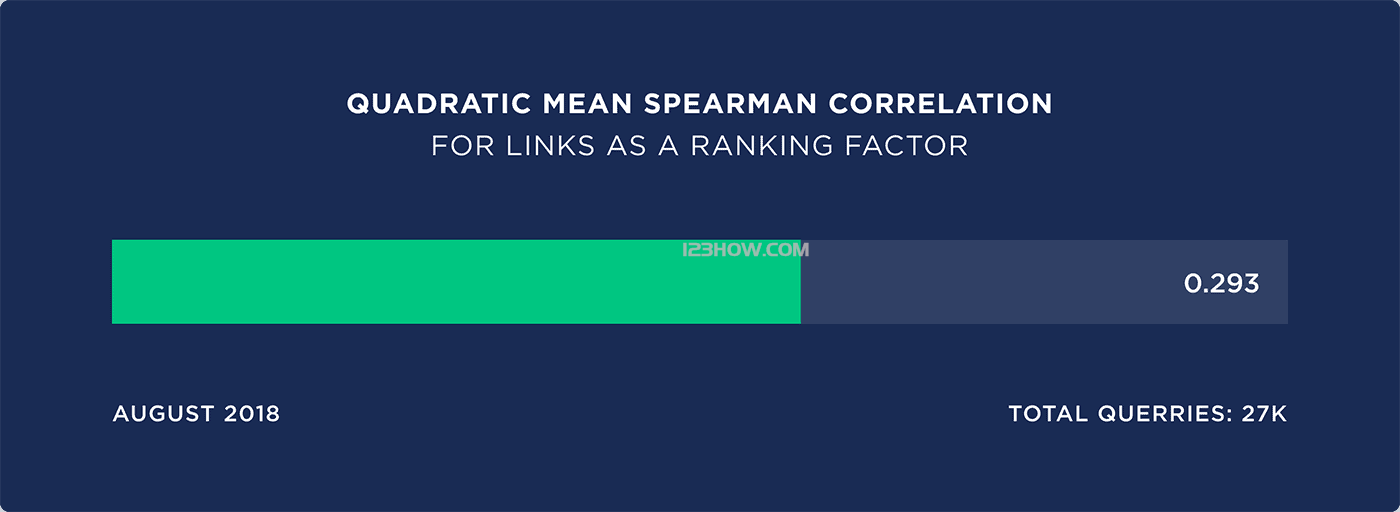
This means they are still a key factor in Google rankings. The question is: how do you do it?
You need to figure out why people are linking to specific content in your industry. Then, include that "Hook" in your content (also known as "hooks").
Let's look at a real-life example: not too long ago, I noticed more and more bloggers writing about voice search.
I've noticed a few other things as well:
When people write about voice search.They will link to content that contains statistics and information::

So, I decided to conduct a statistics-laden voice search study. The result: to date, this single post has garnered 5.6K backlinks, and more than 90% of those backlinks cite specific statistics from my post:
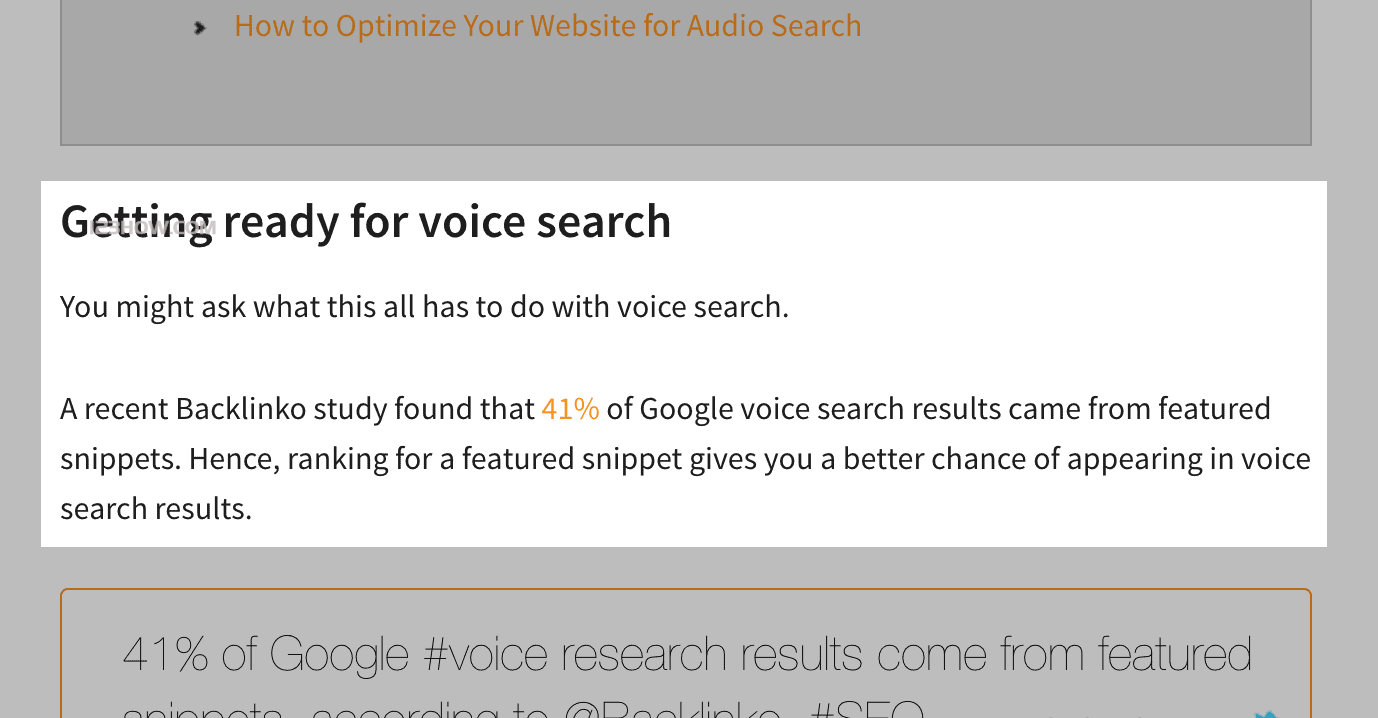
That is, data is just a "hook" that you can use to build links to your content.Another Hook that works well now is Ultimate Guides.
When you publish the Ultimate Guide, your guide itself is The Hook.
I will explain with an example...
A few years ago, I published Link Building: the Definitive Guide. It was (and still is) the most complete guide to link building.
Every now and then, a blogger will mention "link building" in a blog post. But they don't have the space to cover the whole topic.
So they linked to my guide as a way for their readers to learn more:
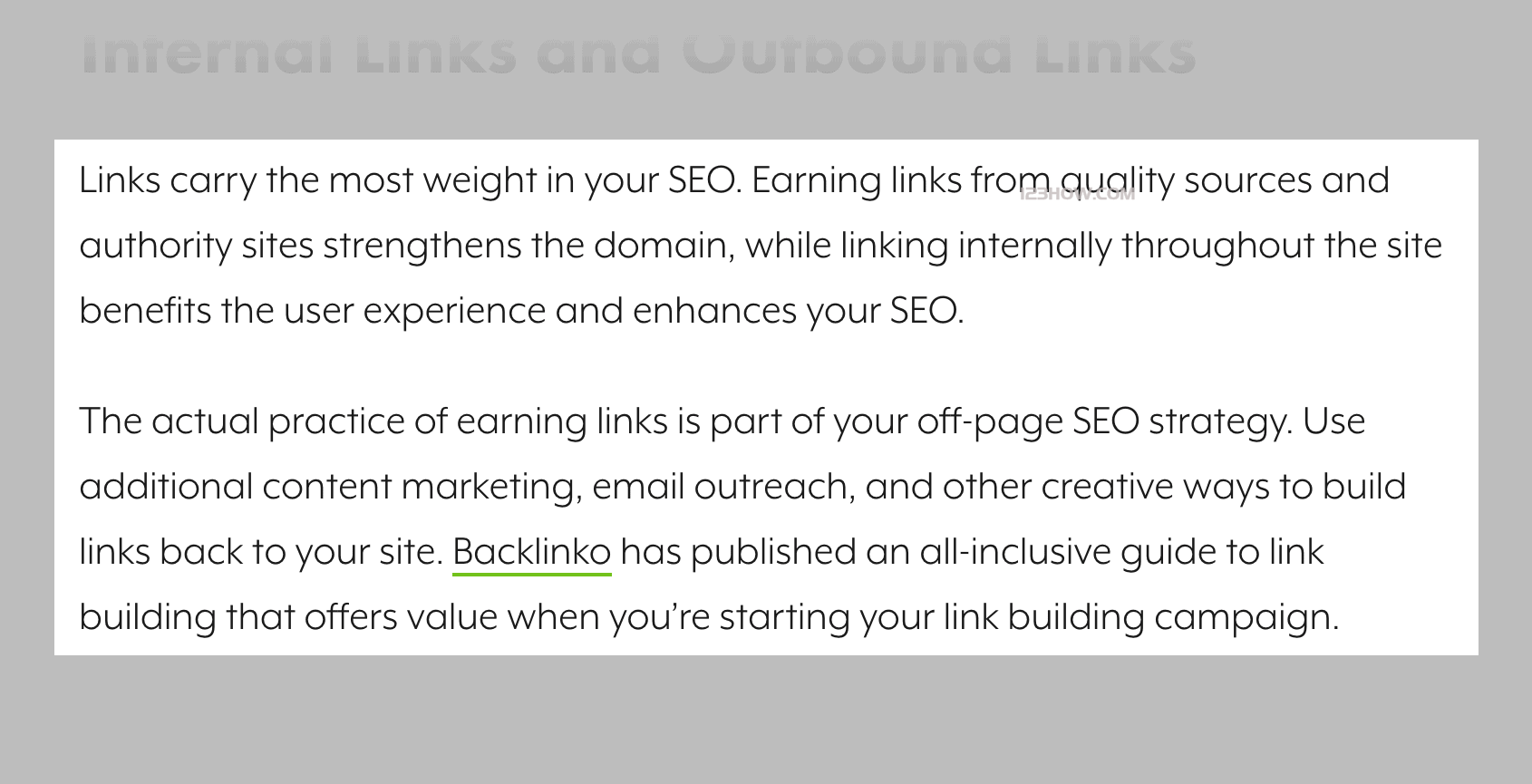
Very cool.
Step 6: Optimize On-Page SEO
This step is entirely about targeting keywords for SEO optimized content.
On-page SEO involves much more than I can cover in one article.
There are three core on-page SEO techniques that I recommend focusing on in 2024.
internal link
Yes, internal linking still works, but you have to lay it out correctly. Specifically, you want to link from high authority pages to pages that need more authority.

For example, a couple years ago I published Google Search Console: the Definitive Guide. So I found a page on my site with lots of permissions and linked to my new guide from that page.
Short, keyword-laden URLs
Our analysis of 11.8 million Google search results revealed something that surprised many: when it comes to search engine optimization, theShort URLs usually outperform long URLsThe
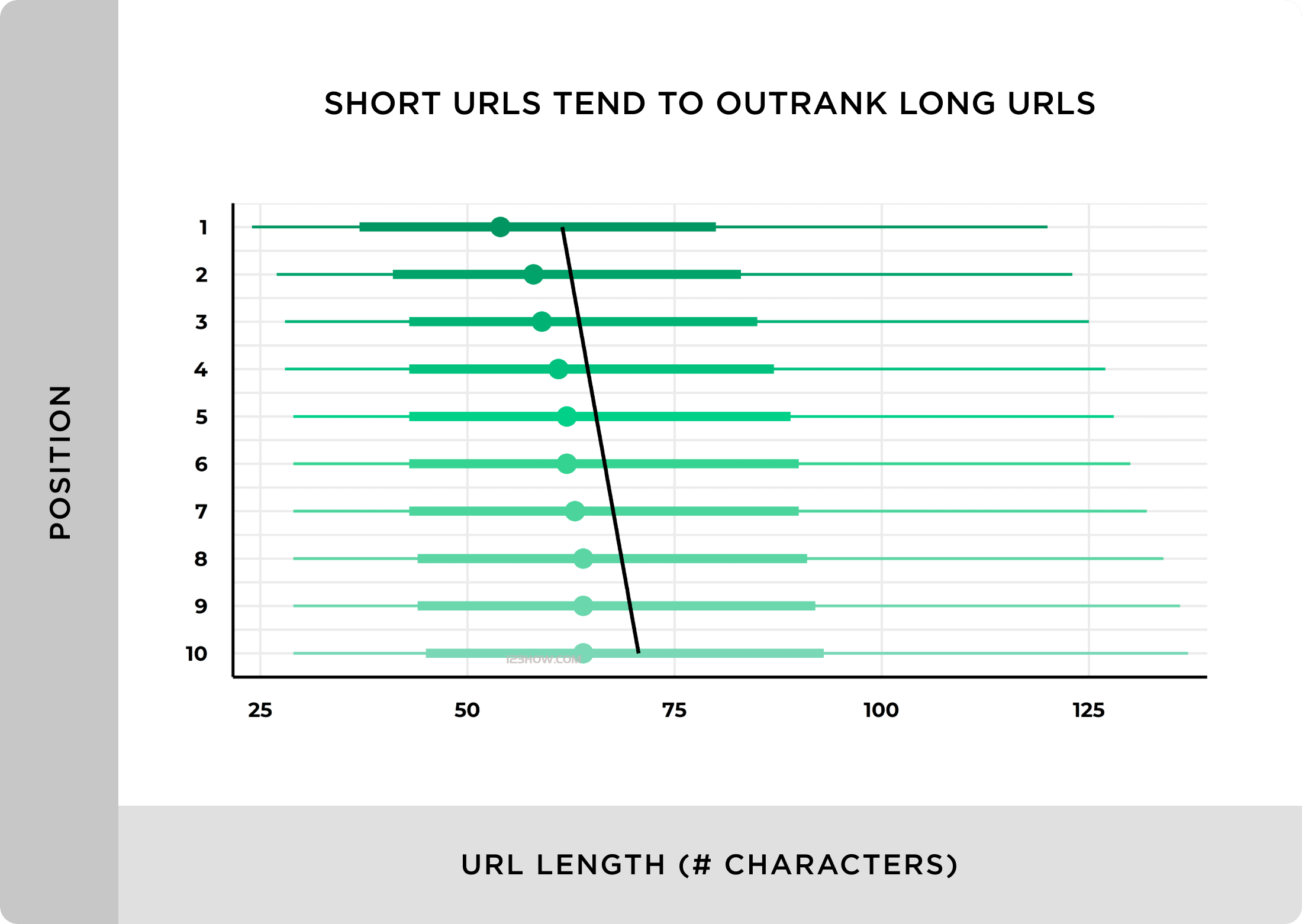
That's why I put my URL either just my keyword, or my target keyword plus one more word, whichever works.
Semantic SEO
Finally, I optimized my content for semantic SEO.
In other words: I find words related to the target keyword. Then, I use those terms in my content, To perform this action yourself, enter the target keyword in Google Images.
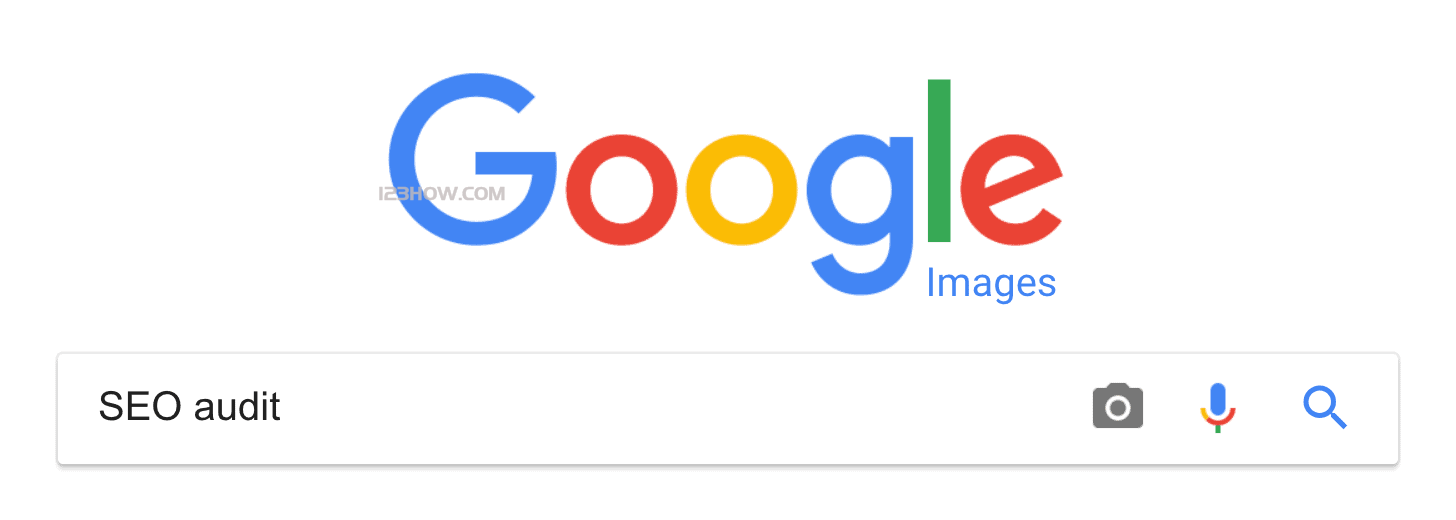
And Google will provide words and phrases that they think are closely related to the topic:

Then, enter the same keywords into a regular Google search. Then scroll down to the "Related Searches" section.
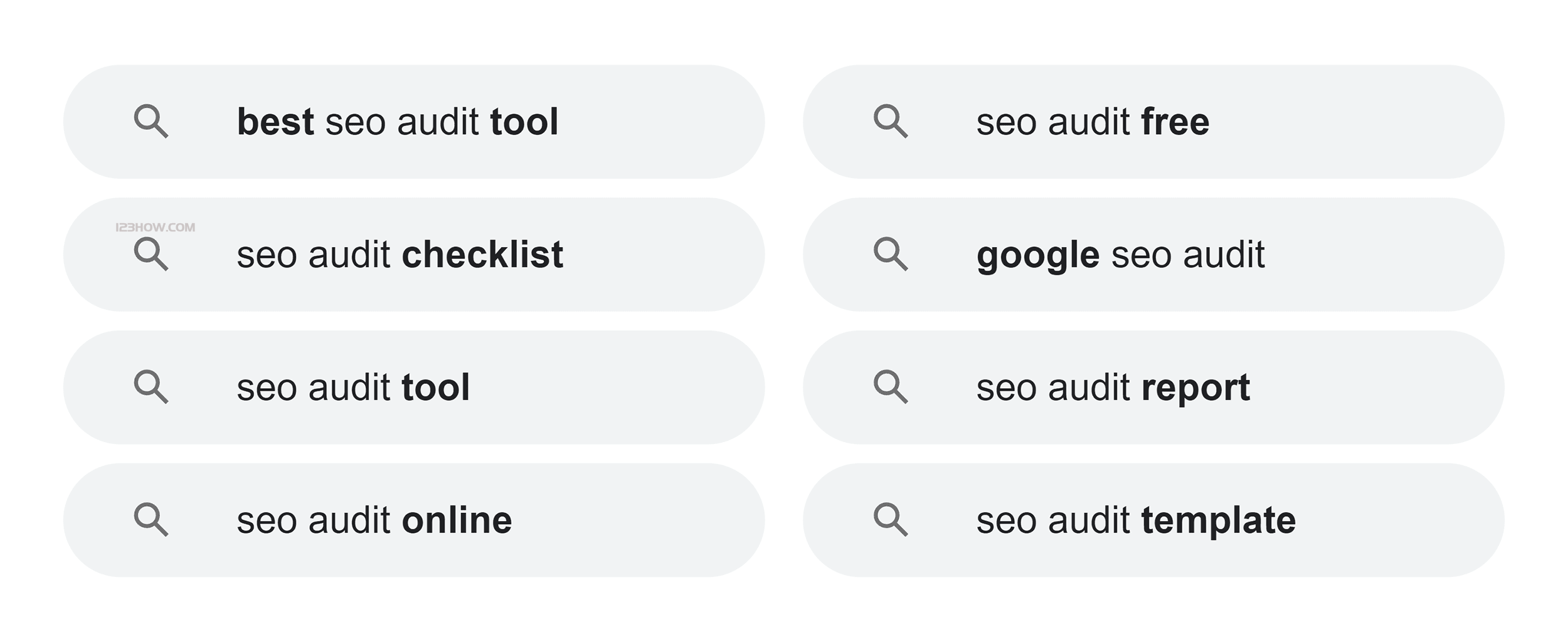
Finally, it will beyouAny terms found sprinkled intoyouIt is sufficient to be in the content of the
Step 7: Optimize for Search Intent
In other words: skyscraper technology 2.0. i'll show you how it works with a quick example.
A couple years ago, I wrote an article about driving more traffic to your website. It performed OK, but it never ranked in the top 5 for the keywords I was targeting ("increase website traffic").
When I analyzed the first page of Google, I realized why:My page does not fulfill the search intent for that keyword.
In fact, most most of the content rankings on "Increase Website Traffic" list some short traffic tips.
For example, "20 Ways to Increase Your Website Traffic", "150 Ways to Increase Your Website Traffic".
But my post gave them an advanced process and frankly wasn't title party enough.
This is not the user experience that search engine visitors want. Therefore, I rewrote my content to match the search intent for this keyword.
So I turned my process into a list post, "28 Ways to Increase Website Traffic in 2024"
After the change, the content matched the search intent and it ranked in the top 3 for my target keywords. This resulted in a 70.43% increase in search engine traffic over the old version of the post:

That is to say:You should publish content with search intent in mind from the start.
For example, I posted a: Ultimate SEO Audit.
I found that against "SEO Audit"Most of the content on ranking lists non-technical hands-on steps. Therefore, I've included strategies in the article that anyone can use.
For example, the content around these sub-headings: "Step 2: Make sure Google only indexes one version of your site", "Step 5: Find and fix indexing problems", "Step 7: Improve your on-page search engine optimization " and so on, these simple and doable hands-on actions.
this timeSearch Intent OptimizationHelped my post get to the first page of Google within a month.
Step 8: Focus on content design
design is probably the most underrated part of content marketing.youCan have the best content ever.
If it looks like this...
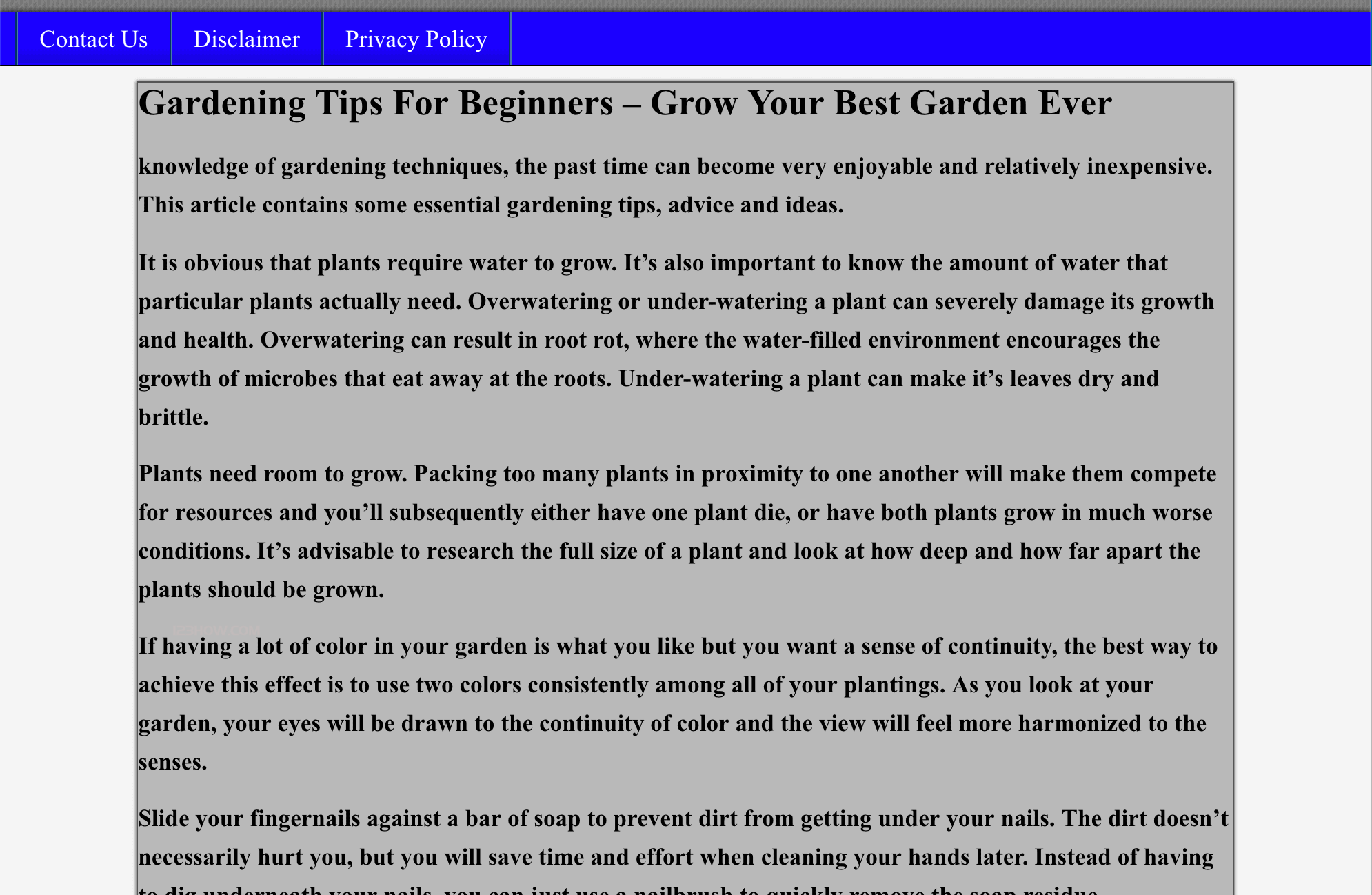
The ugly ones are basically unreadable, which is why I put a lot of my marketing budget into content design.
Here are 4 types of visual content that are super easy to implement:
Graphs and charts
These charts are so effective that I try to include at least one chart in every post.
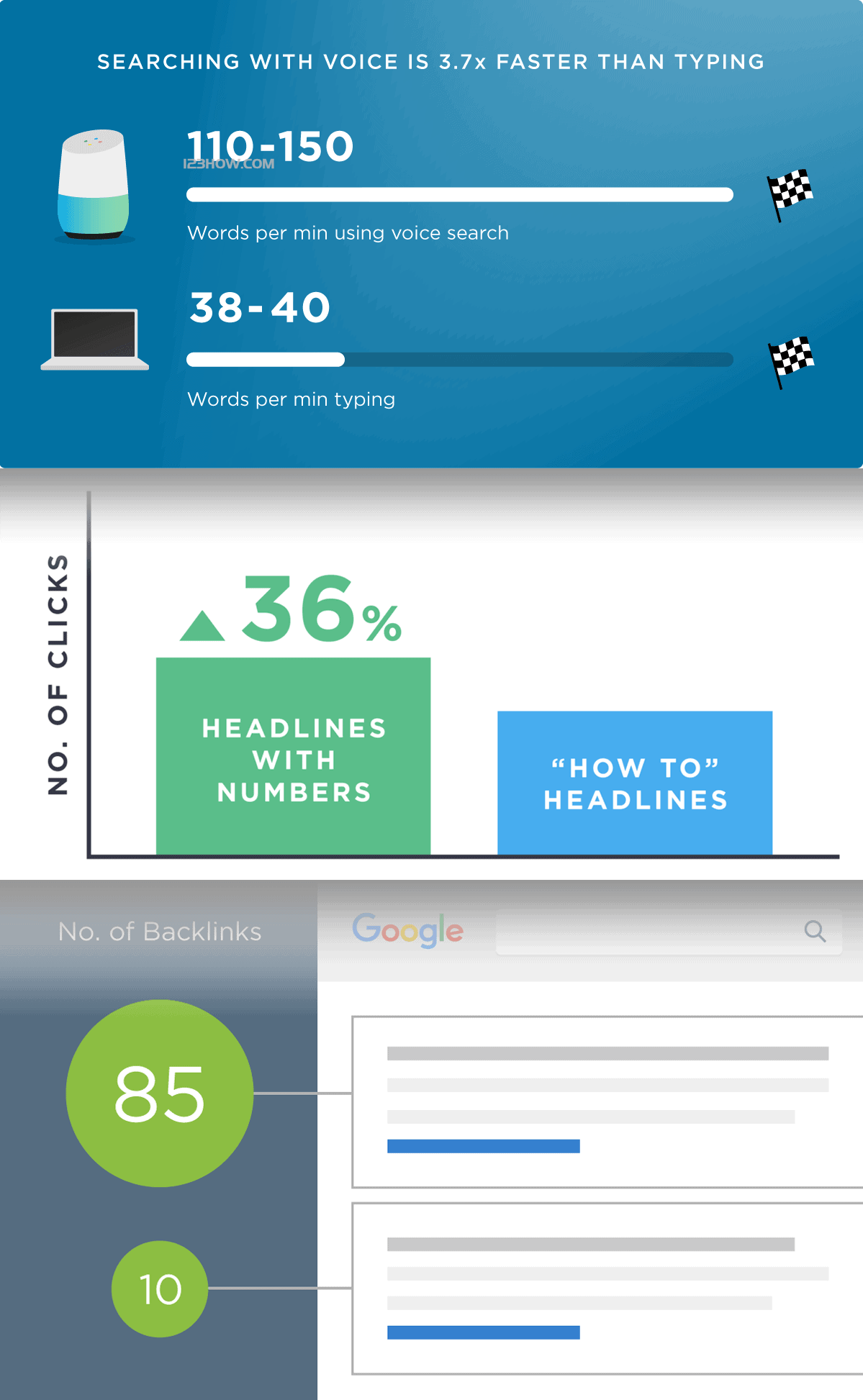
Why?
Because they make the data easy to understand.
For example, get this statistic from my mobile SEO guide.
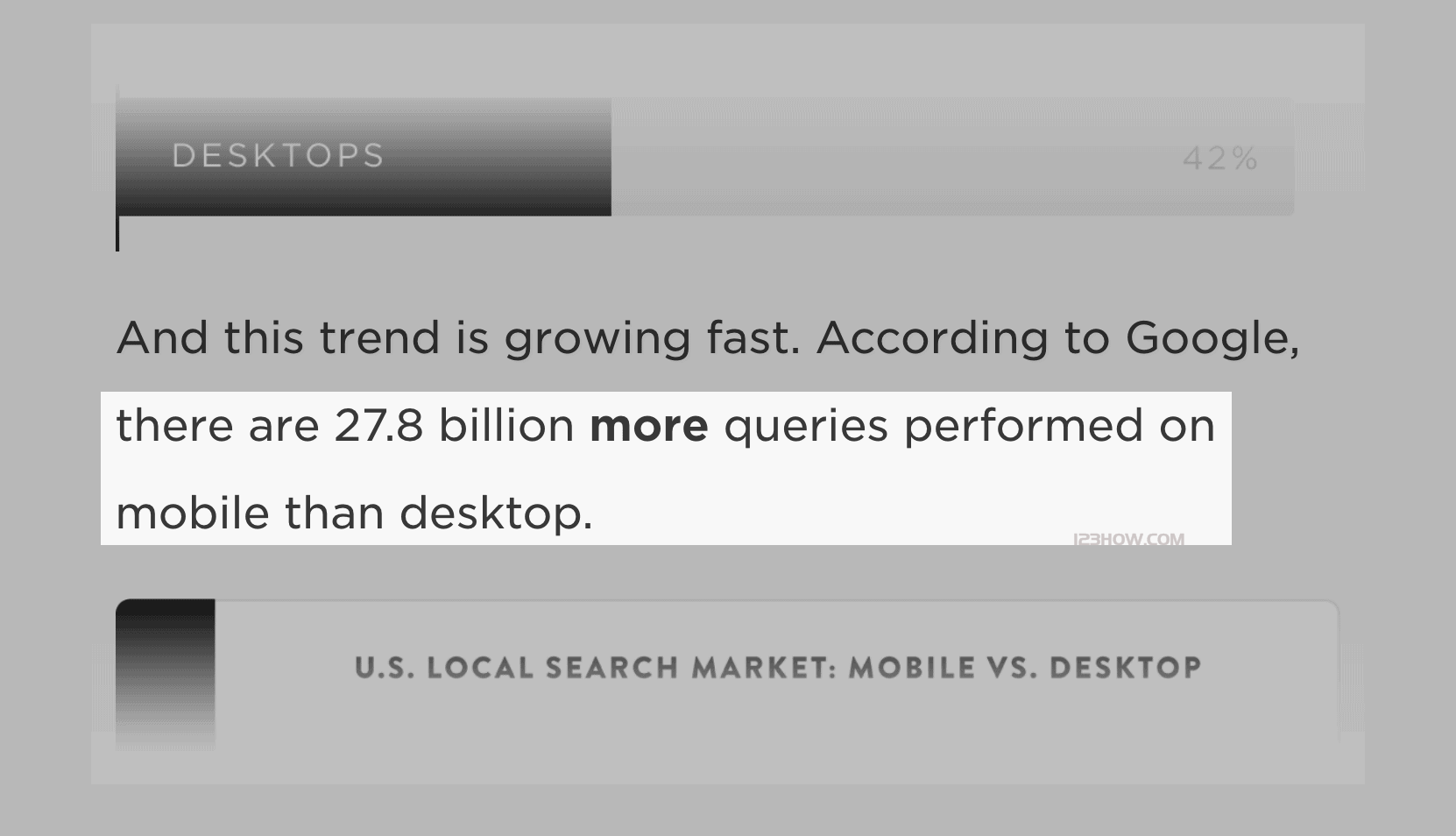
I don't know about you, but it's hard for me to imagine what 27.8 billion is like.
So I had our designer create a nice chart.
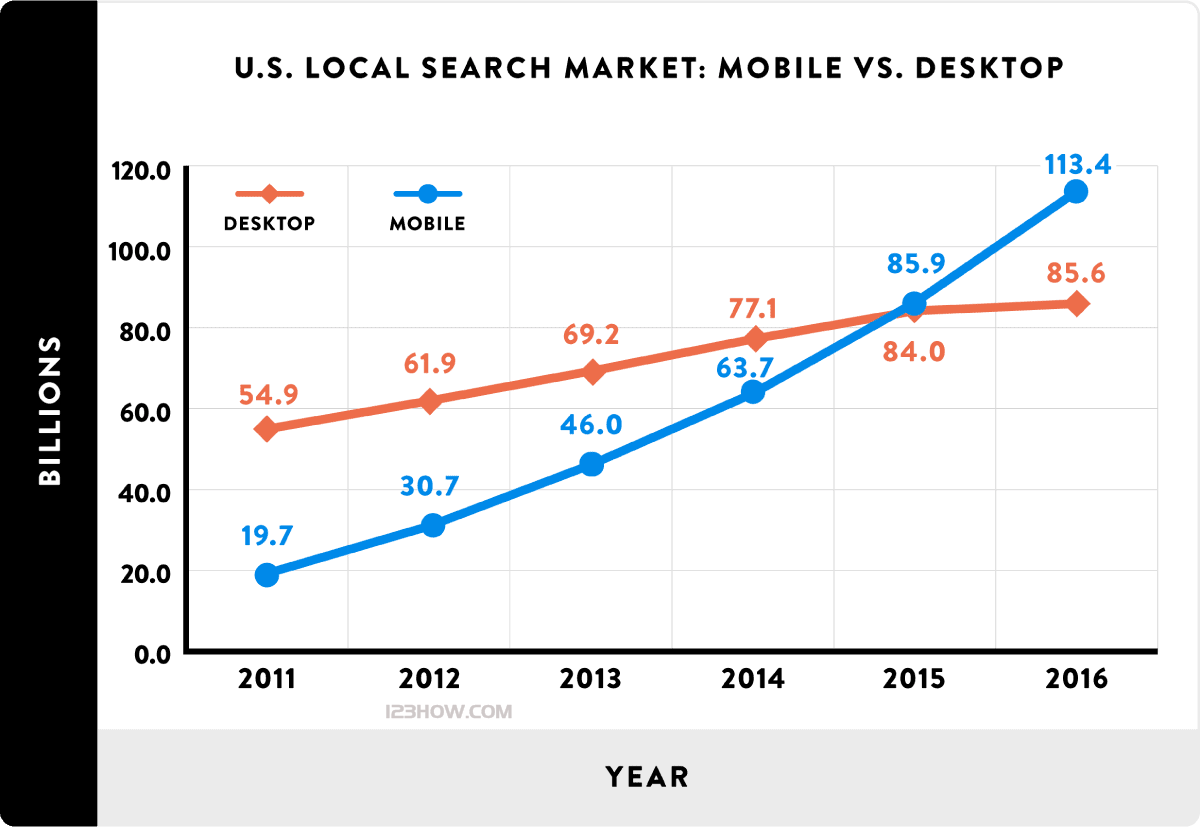
As a bonus, people sometimes use your charts in blog posts and link back to you:
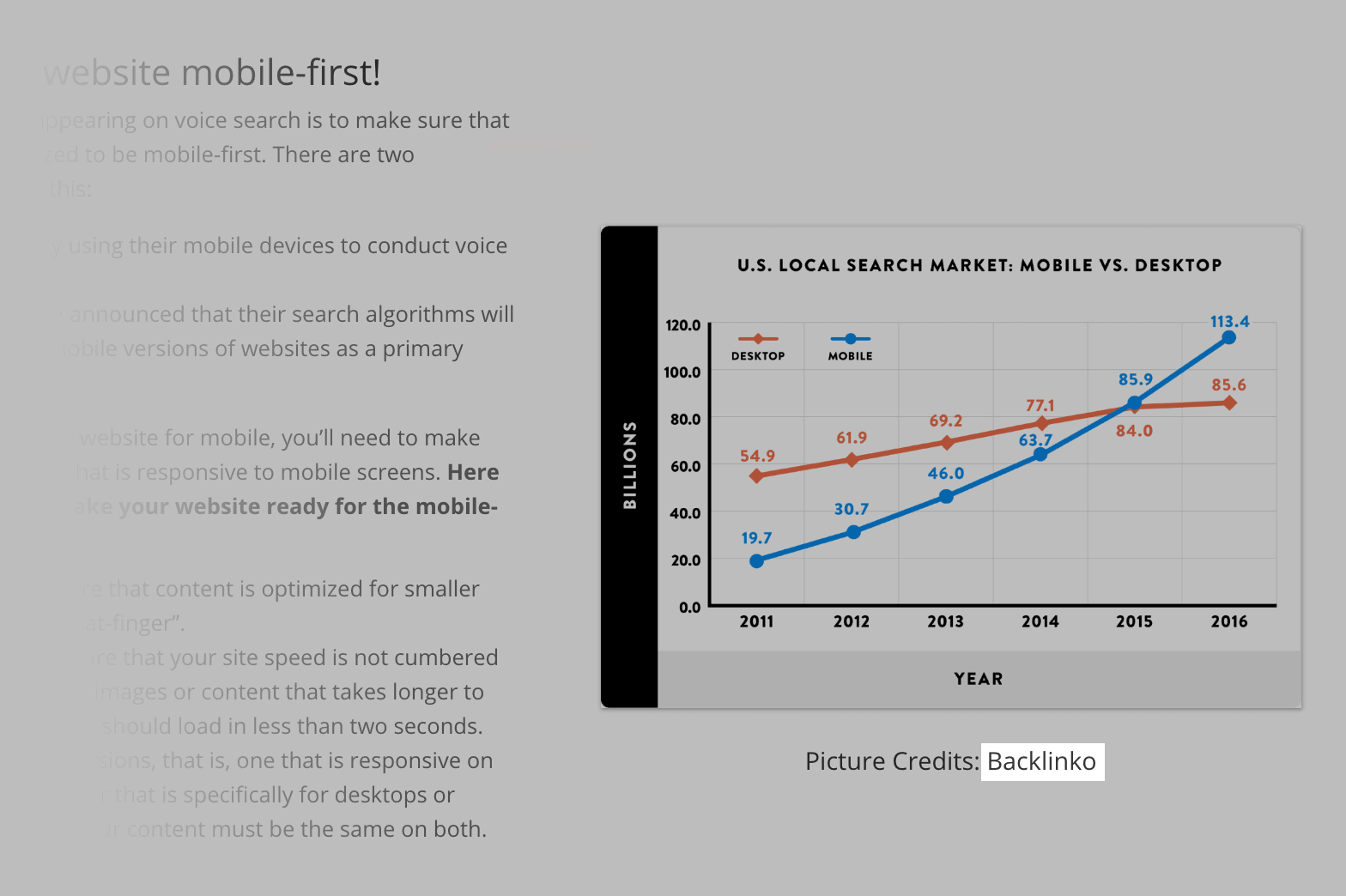
Screenshots and images
You may have noticed that I use a lot of screenshots in each post.
However, I don't use screenshots just for the sake of using them, I only use them when it helps someone achieve a specific step.
For example, these screen shots make the 2 steps in this guide easier to follow:
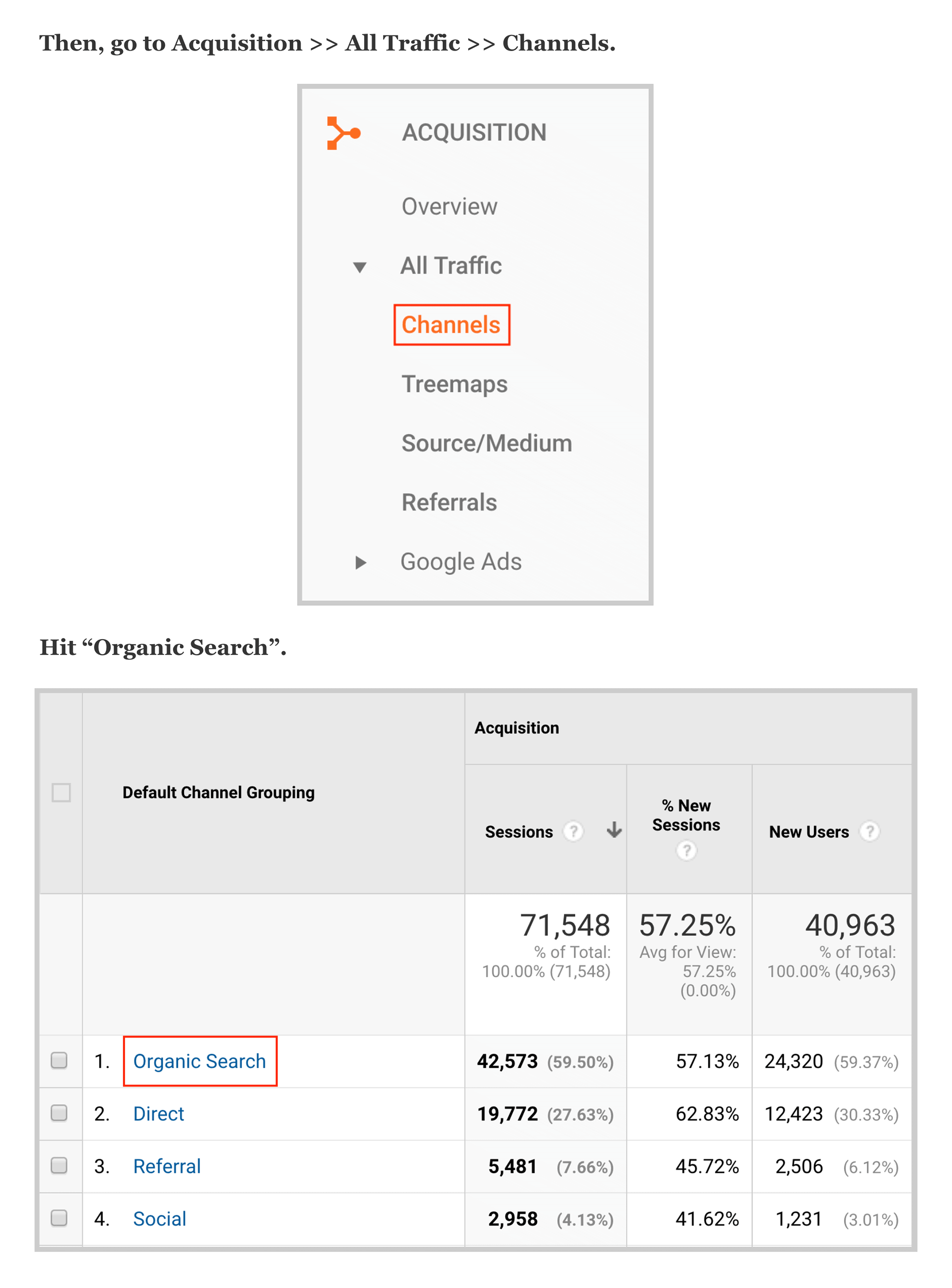
In other words: screenshots only make sense when describing technical content.
If you're in a non-technical field ...... like fitness, images serve the same purpose.
For example, my friend Steve Kamb at Nerd Fitness uses pictures to show you how to do a workout properly:
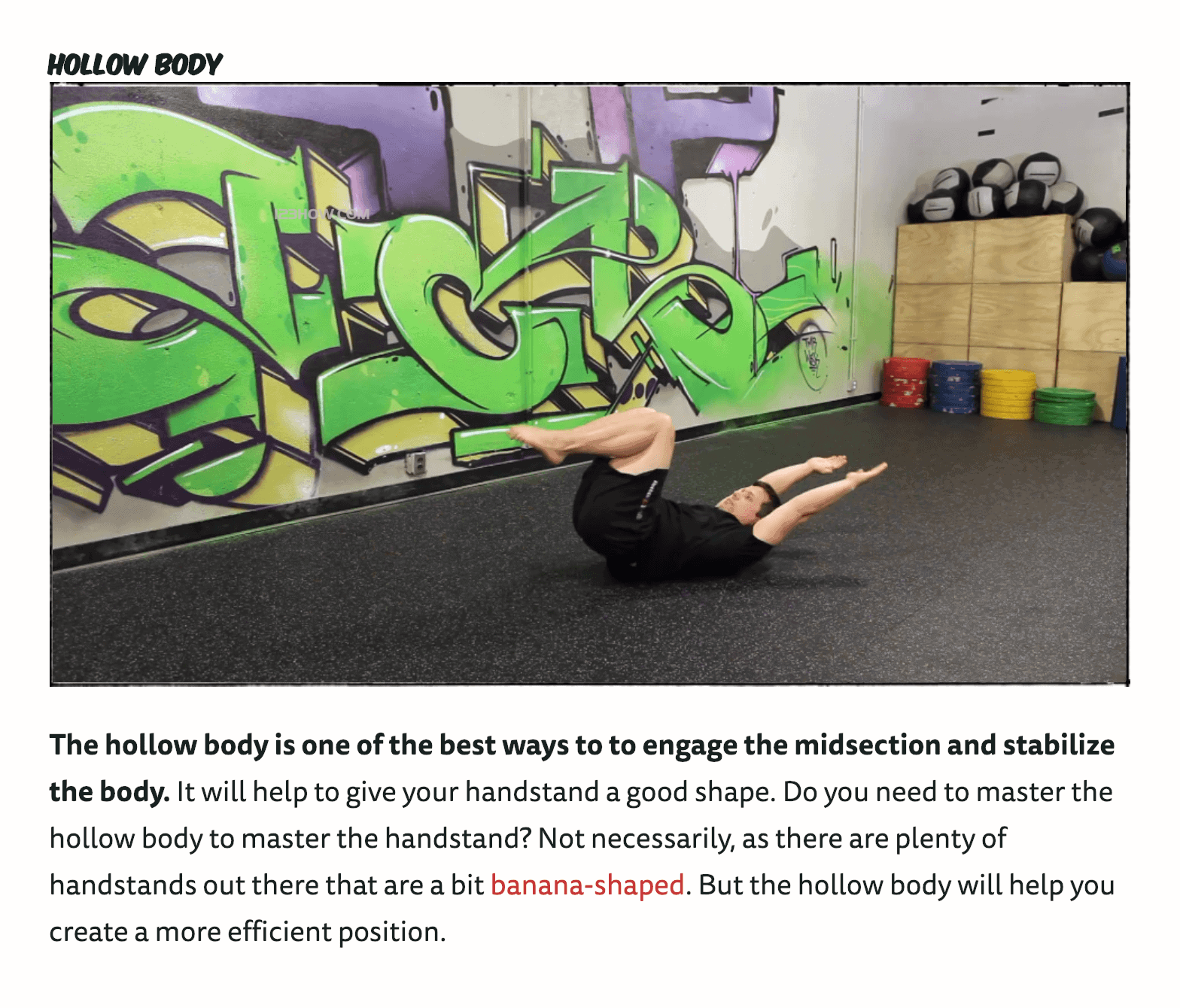
Blog post banners(Cover photo)
Unlike charts and screenshots, blog post banners have no practical use. They look really cool and I generally use the same style of cover image for my blogs.
Graphics and Visualization
Graphs and visualizations are kind of like charts, but instead of visualizing data, they visualize concepts.
For example, in this post, I explain why your website domains should all redirect to the same URL:
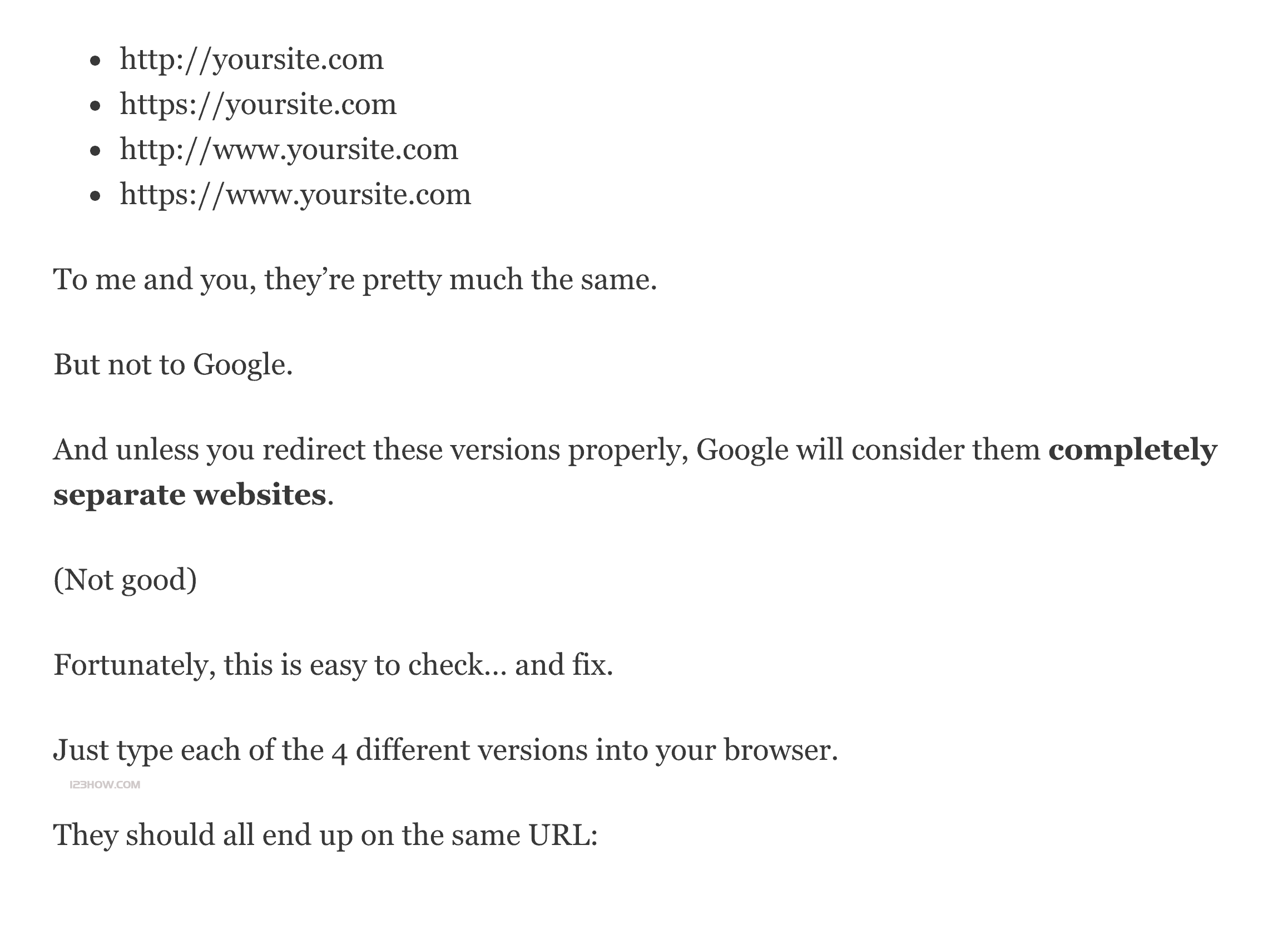
The concept isn't a learned one, but it's hard to visualize the idea in your head. Therefore, our designers created a simple visualization to make the concept easy to understand:

Step 9: Create toyouLinks to pages
Now it's time to actively build links to your content, and we're going to utilize 3 link building strategies that are currently very effective.
Broken (dead) chain building
For example, if you find dead links on someone's website, you can offer them your content as an alternative (contact the webmaster directly through the contact form on the website).
Remember, your expressed intention is to help webmasters fix dead links, not to deliberately promote their own sites, so you give content must be valuable, the other side will adopt your content.
Competitor Analysis
This strategy is old school, but it still works.
First, find a solution for theyouWebsites that want to rank for the keywords they want to rank for. For example, I am trying to rank for the keyword "SEO Audit".
So I got this result from the first page:
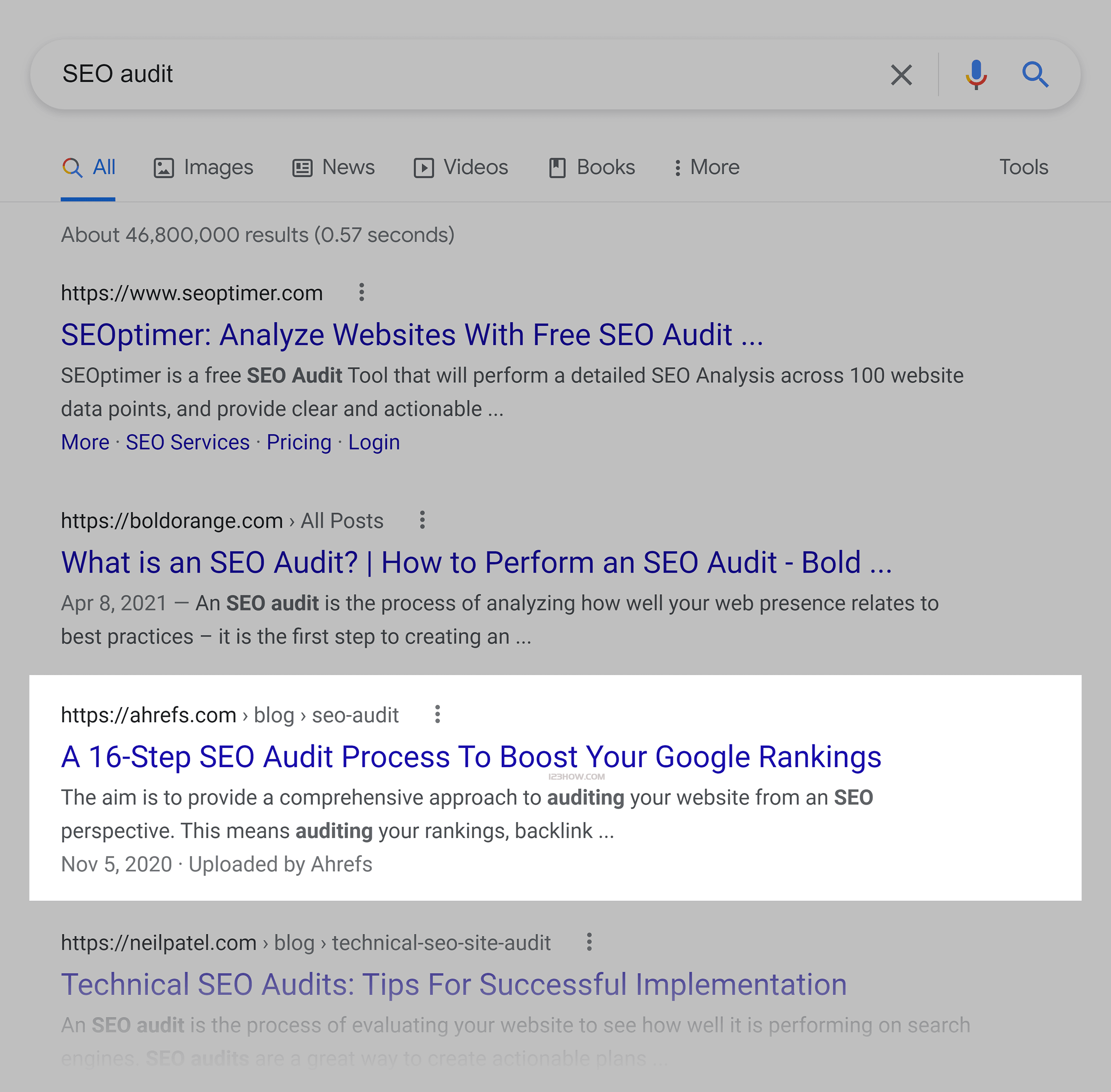
Check out their backlinks:

You can see that this page has backlinks from 407 domains:

Therefore, I should be able to get at least a fraction of the same links they have. To do this, I look at their backlinks one by one.
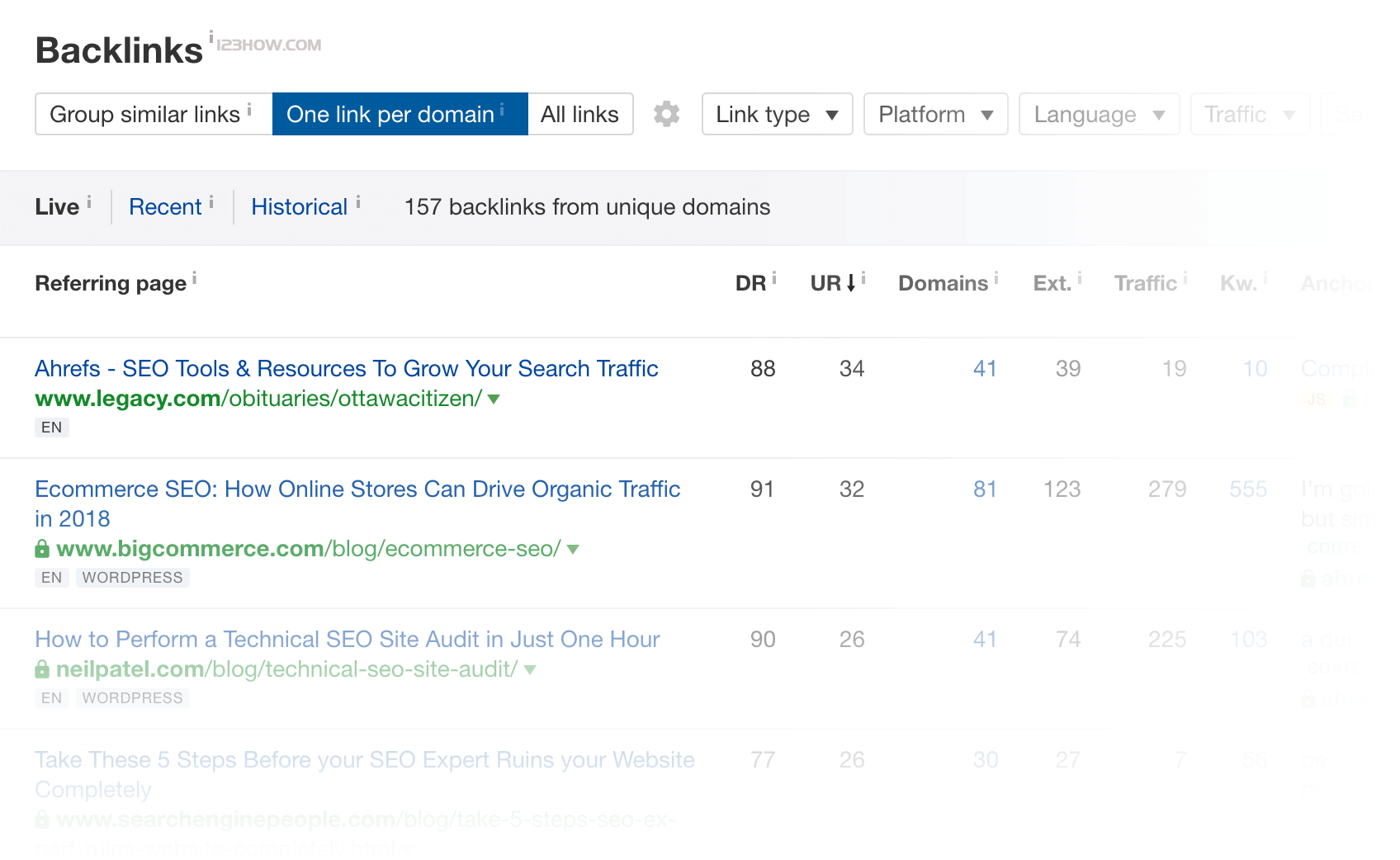
And finding my link canadding valueThe page.
For example, this article mentions my competitor's content and mentions the name:

No need to link to my post there. So I moved on to the next opportunity on the list.
And then I saw this article:
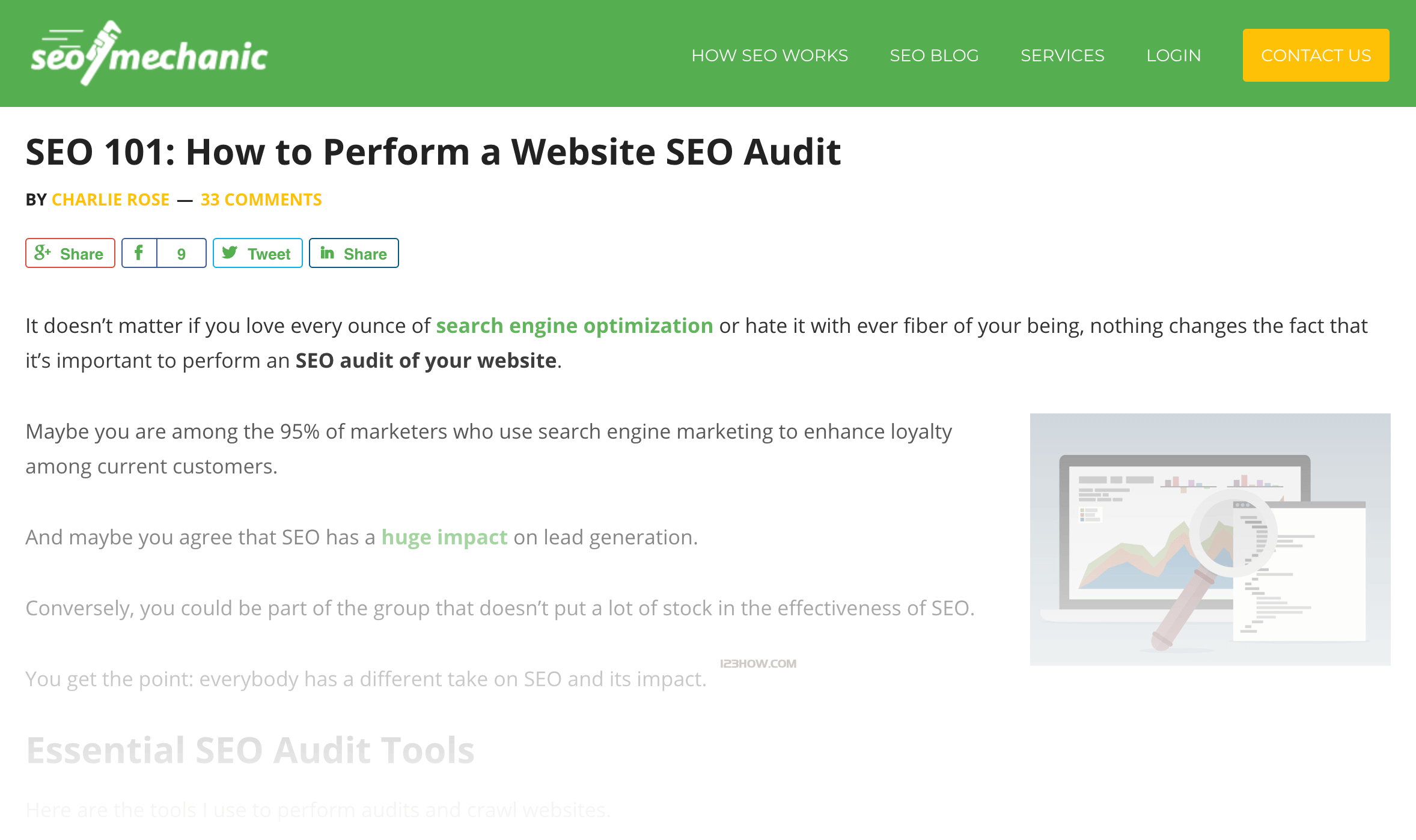
This time, the link to my competitor's page was part of a large resource list.
A list that would be better and more complete with a link to my SEO Audit article. So you can then contact the person and show them your value.
Sharer's approach
This strategy has less to do with linking and more to do with putting theyouThe content is displayed in front of the right people. (E.g., people who run blogs in your field.)
Promote your website by sharing knowledge about your field, training and teaching and such. Just like I used to doOnline Money Making ProgramTraining, it will record some free courses to post to the forum, after spreading, the whole network can be searched everywhere to find my set of courses.
Step 10: Improvements and updatesyoucontent
Refurbish previously published articles, note that you are not re-publishing the same content, but modifying and refurbishing the original content, removing invalid content and adding new valid content.
By doing this, I had a page that increased traffic by 62.601 TP3T:
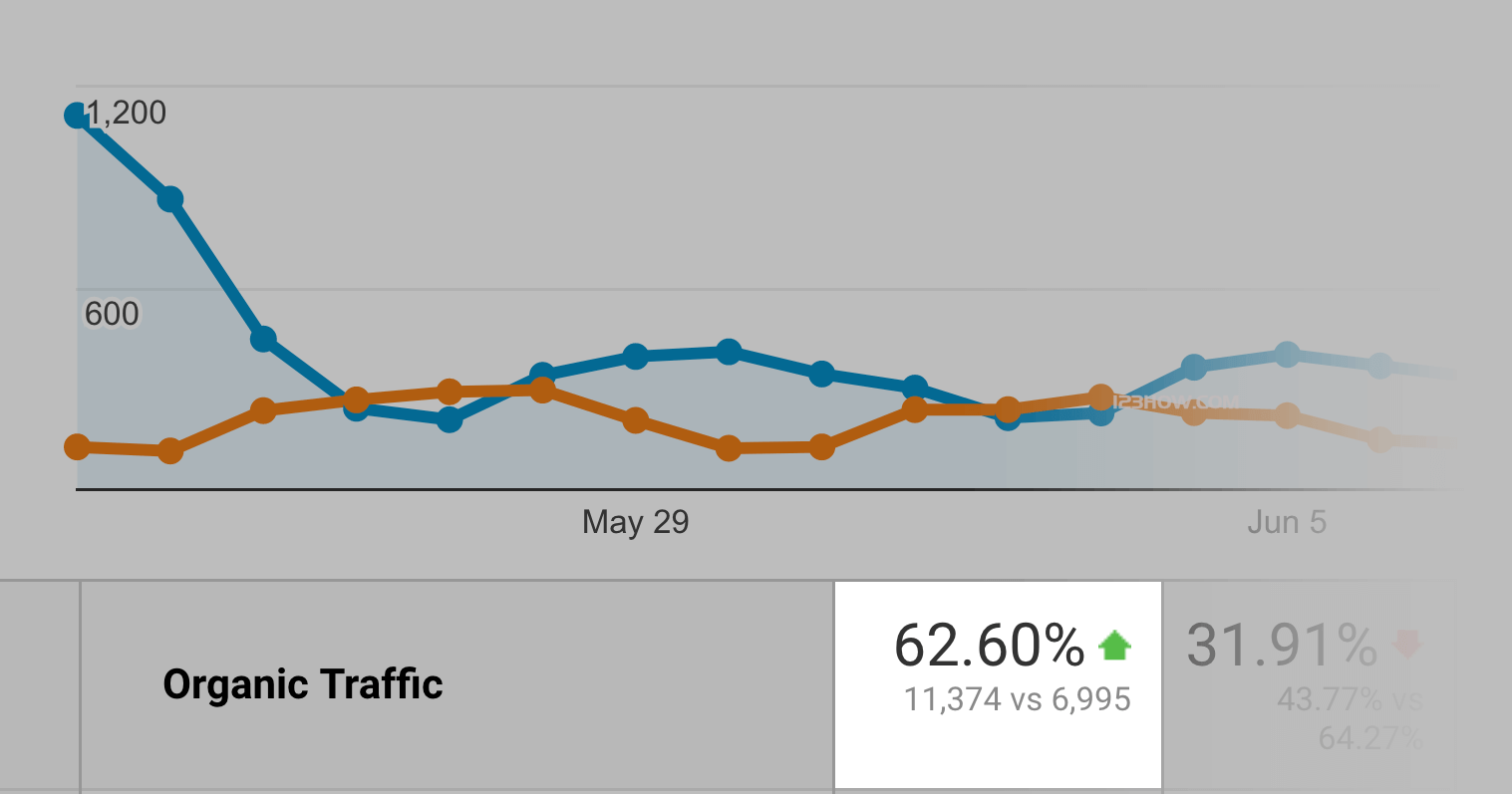
These are the 10 practical SEO strategies of 123HOW.COM website optimization guide, quickly applied to your website! If you still want to know more about basic SEO knowledge, you can go to theSEO Basics TutorialView.
Related posts
Website Settings
URL style switching
URL Card Button
Layout settings
Left Sidebar Menu
Maximum page width
Search box settings
Customize the search box background
Customize the height of the search box
- spotlight
- text
- default (setting)









 Gan Gongwang Anbei 36070002000003
Gan Gongwang Anbei 36070002000003